Description
| Product Name: | NPC1 Rabbit pAb |
| Product Code: | CAB3993 |
| Size: | 20uL, 50uL, 100uL |
| Synonyms: | NPC1, NPC |
| Applications: | WB |
| Reactivity: | Human |
| Host Species: | Rabbit |
| Immunogen: | Recombinant fusion protein containing a sequence corresponding to amino acids 23-260 of human NPC1 (NP_000262.2). |
| Applications: | WB |
| Recommended Dilutions: | WB 1:500 - 1:2000 |
| Reactivity: | Human |
| Immunogen: | Recombinant fusion protein containing a sequence corresponding to amino acids 23-260 of human NPC1 (NP_000262.2). |
| Purification Method: | Affinity purification |
| Storage: | Store at -20°C. Avoid freeze / thaw cycles. Buffer: PBS with 0.02% sodium azide, 50% glycerol, pH7.3. |
| Isotype: | IgG |
| Sequence: | QSCV WYGE CGIA YGDK RYNC EYSG PPKP LPKD GYDL VQEL CPGF FFGN VSLC CDVR QLQT LKDN LQLP LQFL SRCP SCFY NLLN LFCE LTCS PRQS QFLN VTAT EDYV DPVT NQTK TNVK ELQY YVGQ SFAN AMYN ACRD VEAP SSND KALG LLCG KDAD ACNA TNWI EYMF NKDN GQAP FTIT PVFS DFPV HGME PMNN ATKG CDES VDEV TAPC SCQD CSIV CGPK PQPP PPPA PW |
| Gene ID: | 4864 |
| Uniprot: | O15118 |
| Cellular Location: | Late endosome membrane, Lysosome membrane, Multi-pass membrane protein |
| Calculated MW: | 107kDa/142kDa |
| Observed MW: | Refer to figures |
| UniProt Protein Function: | NPC1: Intracellular cholesterol transporter which acts in concert with NPC2 and plays an important role in the egress of cholesterol from the endosomal/lysosomal compartment. Both NPC1 and NPC2 function as the cellular 'tag team duo' (TTD) to catalyze the mobilization of cholesterol within the multivesicular environment of the late endosome (LE) to effect egress through the limiting bilayer of the LE. NPC2 binds unesterified cholesterol that has been released from LDLs in the lumen of the late endosomes/lysosomes and transfers it to the cholesterol-binding pocket of the N-terminal domain of NPC1. Cholesterol binds to NPC1 with the hydroxyl group buried in the binding pocket and is exported from the limiting membrane of late endosomes/ lysosomes to the ER and plasma membrane by an unknown mechanism. Binds oxysterol with higher affinity than cholesterol. May play a role in vesicular trafficking in glia, a process that may be crucial for maintaining the structural and functional integrity of nerve terminals. Defects in NPC1 are the cause of Niemann-Pick disease type C1 (NPC1). A lysosomal storage disorder that affects the viscera and the central nervous system. It is due to defective intracellular processing and transport of low-density lipoprotein derived cholesterol. It causes accumulation of cholesterol in lysosomes, with delayed induction of cholesterol homeostatic reactions. Niemann-Pick disease type C1 has a highly variable clinical phenotype. Clinical features include variable hepatosplenomegaly and severe progressive neurological dysfunction such as ataxia, dystonia and dementia. The age of onset can vary from infancy to late adulthood. An allelic variant of Niemann-Pick disease type C1 is found in people with Nova Scotia ancestry. Patients with the Nova Scotian clinical variant are less severely affected. Belongs to the patched family. Protein type: Membrane protein, integral; Membrane protein, multi-pass Chromosomal Location of Human Ortholog: 18q11.2 Cellular Component: Golgi apparatus; membrane; lysosome; perinuclear region of cytoplasm; integral to plasma membrane; lysosomal membrane; late endosome membrane; endoplasmic reticulum; extracellular region; integral to membrane; nuclear envelope; lipid raft Molecular Function: protein binding; transmembrane receptor activity; sterol transporter activity; hedgehog receptor activity; cholesterol binding; receptor activity Biological Process: response to drug; cholesterol metabolic process; lysosomal transport; cholesterol transport; bile acid metabolic process; protein amino acid glycosylation; cholesterol efflux; endocytosis; signal transduction; adult walking behavior; negative regulation of macroautophagy; cholesterol homeostasis; response to cadmium ion; autophagy; lipid raft organization and biogenesis Disease: Niemann-pick Disease, Type C1 |
| UniProt Protein Details: | |
| NCBI Summary: | This gene encodes a large protein that resides in the limiting membrane of endosomes and lysosomes and mediates intracellular cholesterol trafficking via binding of cholesterol to its N-terminal domain. It is predicted to have a cytoplasmic C-terminus, 13 transmembrane domains, and 3 large loops in the lumen of the endosome - the last loop being at the N-terminus. This protein transports low-density lipoproteins to late endosomal/lysosomal compartments where they are hydrolized and released as free cholesterol. Defects in this gene cause Niemann-Pick type C disease, a rare autosomal recessive neurodegenerative disorder characterized by over accumulation of cholesterol and glycosphingolipids in late endosomal/lysosomal compartments.[provided by RefSeq, Aug 2009] |
| UniProt Code: | O15118 |
| NCBI GenInfo Identifier: | 83305902 |
| NCBI Gene ID: | 4864 |
| NCBI Accession: | O15118.2 |
| UniProt Secondary Accession: | O15118,Q9P130, B4DET3 |
| UniProt Related Accession: | O15118 |
| Molecular Weight: | 1278 |
| NCBI Full Name: | Niemann-Pick C1 protein |
| NCBI Synonym Full Names: | Niemann-Pick disease, type C1 |
| NCBI Official Symbol: | NPC1 |
| NCBI Official Synonym Symbols: | NPC |
| NCBI Protein Information: | Niemann-Pick C1 protein |
| UniProt Protein Name: | Niemann-Pick C1 protein |
| UniProt Synonym Protein Names: | |
| Protein Family: | Niemann-Pick C1 protein |
| UniProt Gene Name: | NPC1 |
| UniProt Entry Name: | NPC1_HUMAN |






